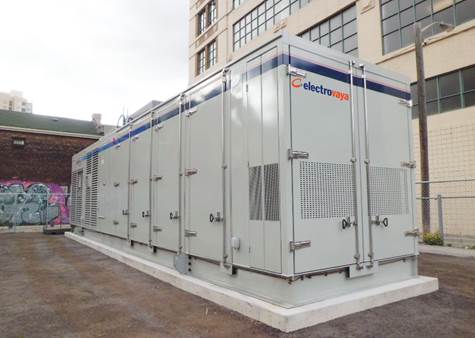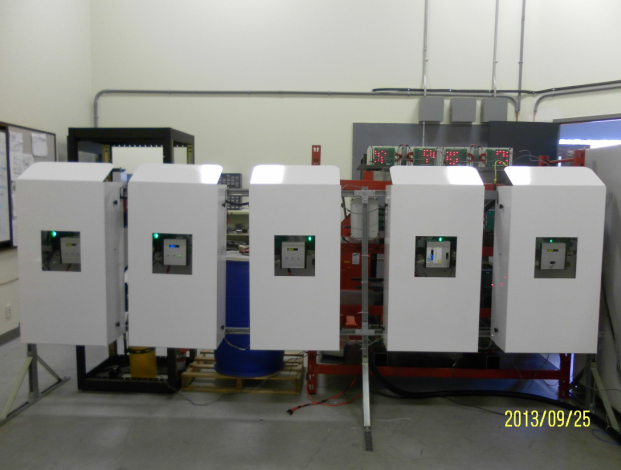Utility Scale Electricity Storage Demonstration Using New and Re-purposed Lithium Ion Automotive Batteries
Lead Proponent: Electrovaya
CEF Contribution: $ 3.66 M
Project Total: $ 7.6 M
Strategic Area: Electricity Storage
Project Background

Electrovaya's Battery Energy Storage System (BESS) installed in downtown Toronto
Electricity storage is becoming increasingly recognized as an essential component of the future electrical grid. Efficient electricity storage would play a key role in helping to manage variable and intermittent renewable energy sources, and enabling more renewable energy to be integrated into the grid. Additionally, storage would allow excess renewable energy generated at times of low demand to be held, and effectively shifted, to times of high demand. The use of utility-scale electricity storage to meet peak power requirements in urban centres such as Toronto and Ottawa could potentially delay the need for substation upgrades, transmission line extensions, and/or new generating capacity.
Globally, the implementation of various utility-scale energy storage technologies is just beginning. The evolution of battery energy storage technology to one that is more cost effective and has higher energy density, increased reliability, longer operating life, and improved safety is the principal focus of the industry. To that end, Electrovaya proposed the project “Utility Scale Electricity Storage Demonstration Using New and Re-purposed Lithium Ion Automotive Batteries” for funding. The Project was awarded $3.7M from CEF to demonstrate the capabilities, versatility and economics of utility-scale electricity storage based on modular lithium-ion (Li-ion) polymer battery technology.
Results

Manitoba Hydro HVDC Research Centre set-up for evaluating repurposed automotive battery packs for a second life as stationary storage for utilities
Phase I of the project involved the design, fabrication and testing of a Li-ion SuperPolymer® 2.0 battery energy storage system (BESS). The system was housed within a custom container (similar to a tractor trailer) measuring approximately 4 x 3 x 14 metres (13 x 10 x 46 feet). The container was separated into several compartments. The battery compartment accommodated approximately 5000 individual Li-ion battery cells (150 kW total capacity). The other compartments (control, electrical and HVAC compartments) held the rest of the system, including the DC breaker, switchgear, transformer, etc. Because the system would eventually be installed in an urban neighbourhood, it underwent extensive design validation and components such as the cell, module and battery management system and thermal management/cooling system had to be upgraded, in order to address potential safety and fire hazards. The completed BESS was fully tested before being transported to Ryerson University’s Campus in downtown Toronto and subsequently connected to the grid via overhead cables. The BESS is currently undergoing real-world testing to demonstrate its ability to store off-peak power and provide high-quality power on demand.
In Phase II of the project, Electrovaya’s partner Manitoba HVDC Research Centre (MHRC), a division of Manitoba Hydro International Ltd., successfully developed and tested a utility-size prototype battery system in their laboratory facilities using five second‐life automotive Li-ion batteries independently coupled to DC‐DC converters. The DC-DC converters were connected to a common DC-bus, which was then grid-tied using a 600 VAC Voltage Source Converter (VSC). A master control system managed the charge and discharge of each battery through the DC‐DC converters. The assembled battery system was then connected in parallel with a small diesel generator (18 kW) and a programmable load bank, forming what was effectively a microgrid. The prototype microgrid enabled the testing and validation of methods that optimize diesel fuel consumption and reduce emissions of islanded grids (that combine diesel and renewable sources together with storage). The system was fully operational at MHRC’s laboratory facilities.
Benefits to Canada
Advancements in battery energy storage technology, in order to either meet peak demand for electricity in urban centres or repurpose battery systems from automotive to utility application, will benefit not just the battery industry in Canada but also other affected industries where energy storage plays an important role.
Next Steps
Electrovaya will continue to develop its battery technology and battery management systems to a commercial grade. Manitoba Hydro, Toronto Hydro, Hydro One and Ryerson will continue to research and evaluate emerging energy storage solutions.
Page details
- Date modified: